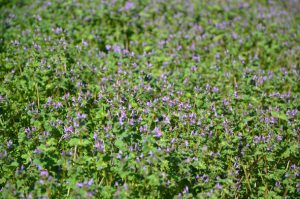
By Les Harrison
Wakulla County Extension Director
The start of 2017 is likely to go down in history as one of the most colorful winters in recent memory. Camellia and azaleas cultivars, both with a non-native heritage, have been providing color consistently.
Less obvious this year, there are other species which add color to the environment. One of these bright spots are geraniums.
Much like the camellias and azalea, geraniums have been cultivated for centuries. While the details are lost to history, the plant was cultivated in Europe for its attractive blooms possibly as early as the 16th Century having originated in southern Africa.
While not in the same genus as the long cultivated ornamental geranium, this sometimes weed (Geranium carolinianum) is in the same plant family. Although not producing as many or as large blooms as its ornamental cousin, the native plant is striking in its own right.
The minute pinkish to purple flowers appear on the end of this herbs stems. The plant is highly adaptable and will grow in a variety of environments.
This early bloomer can tolerate some shade, but prefers full sun. Once established, it will rapidly colonize an area and pushing out competitors to the point of becoming a pest.
These mass appearances add a stark color contrast to the landscape. The green background with the flecks of pink to purple blooms stands in stark contrast to the normally muted seasonal color.
Legumes native to Wakulla County are another early bloomer. They take the temperature swings, even this year, in stride and keep on growing.
Legumes by definition are a plant with a nitrogen producing bacteria attached to their root system. The bacterial activity produces the essential nutrient to the plant giving it a substantial survival advantage over its competitors.
Vetch is the most common naturally occurring legume found in Wakulla County. The low growing plant is easily identified by its elongated dagger-shaped leaves which are half an inch in length.
In spring, this annual plant produces diminutive purple flowers which quickly produce inch-long seed pods. Most of the seed are scattered within a few yard, and over a few years can develop a dense tangle of plants which are attractive to grazing animals.
Honeybees and native pollinators are often seen visiting the blooms. No doubt the early blooms are a treat after a long winter of living off stored honey and pollen in the hive.
Birds and animals can scatter seed to new areas where the hardy plant will aggressively colonize any suitable environment. The primary deterrent to becoming established in the new site is the plant is eaten or killed before its seed are set.
This time of year vetch may be seen in open or partially shaded areas. The plant is six to 12 inches in height, but with no bloom or seed pods.
After a typical frost vetch is left unaffected. The colder temperatures work to vetch’s advantage in that many competing plants are killed or stunted.
Other commonly seen winter legumes in Wakulla County are clovers. Like vetch, they also have a nitrogen fixing bacterial on their roots and they are adept at flourishing in the cold and frosty temperatures.
Even when winter returns, native geraniums and legumes will add color. It is nice to know some things stay the same.

To learn more about vetch and other native legumes in Wakulla County, contact your UF/IFAS Wakulla Extension Office at 850-926-3931 or https://blogs.ifas.ufl.edu/wakullaco/
 0
0
